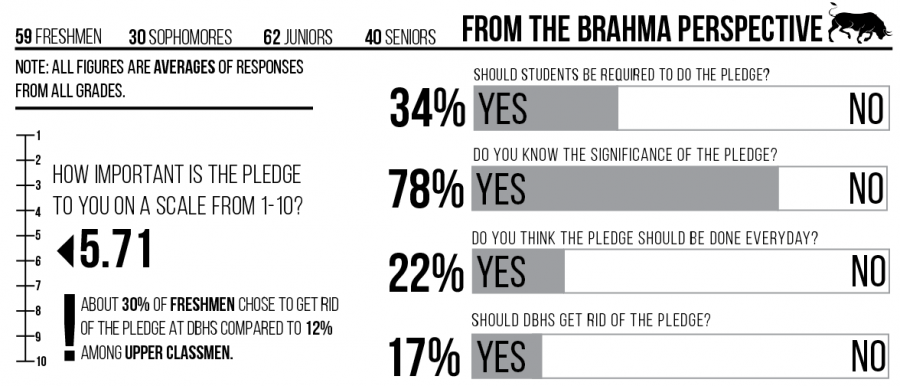Eye of the Editors: The Pledge of Allegiance
The Pledge of Allegiance is a Diamond Bar High School tradition that should either be upheld with an understanding of its significance, or dropped entirely from USB announcements.
Once an ingrained daily routine at all schools, the Pledge of Allegiance occurs weekly for students at Diamond Bar High School. Recitations are held every Monday before USB announcements; but, instead of treating it like the patriotic recitation that it should be, students act as if it is a chore, showing little enthusiasm or knowledge of what they are pledging to.
The robotic, monotonic voices directed toward the flag are a result of elementary memorization. Sluggishly, some students drag themselves up to stand and murmur the words, lazily reciting and saluting the flag. Some classrooms, in fact, don’t even have flags.
Furthermore, the true meaning behind the Pledge of Allegiance is foreign to most students. While some history books skim the tip of the iceberg, others barely touch upon the subject at all, leaving the topic undiscussed.
Though 78 percent of students polled by the Bull’s Eye said they understood the significance of the Pledge, it doesn’t show in their lack of concern during the weekly empty-hearted recitation. Not only are the Pledge’s words foreign to some students, but they seem unaware of the loyalty they are pledging, and therefore, find no reason to take the exercise seriously.
If the school wants to continue the pledge every Monday, students should understand what they are pledging to. There are several quick solutions to change the way students view the pledge. Fourth period teachers could address the importance to students at the beginning of the year, USB could include it in their morning announcements or history teachers could implement it in their lesson plans.
It’s been more than 100 years since the Pledge was introduced to schools. Originally, it was created in hopes of influencing an influx of immigrants to display loyalty towards the United States, and not their homeland. It was later implemented in classrooms, advocating for patriotism against the Communists; in fact, the words “under God” were added to the Pledge in the 1950s, hoping to separate the U.S. from atheist Communist countries.
Due to the Pledge’s oath toward God, controversy regarding religious and cultural backgrounds emerged; now, some schools don’t require students to pledge or stand for the flag salute.
But if the Pledge continues to be treated as a bother by DBHS students, it should be cut from Monday announcements entirely. (It’s doubtful that any class has been led in the Pledge on those occasions when the USB speaker skips the reading.) Without knowledge, the Pledge of Allegiance is just meaningless words.
Your donation will support the student journalists of Diamond Bar High School. Your contribution will allow us to purchase equipment and cover our annual website hosting costs.



